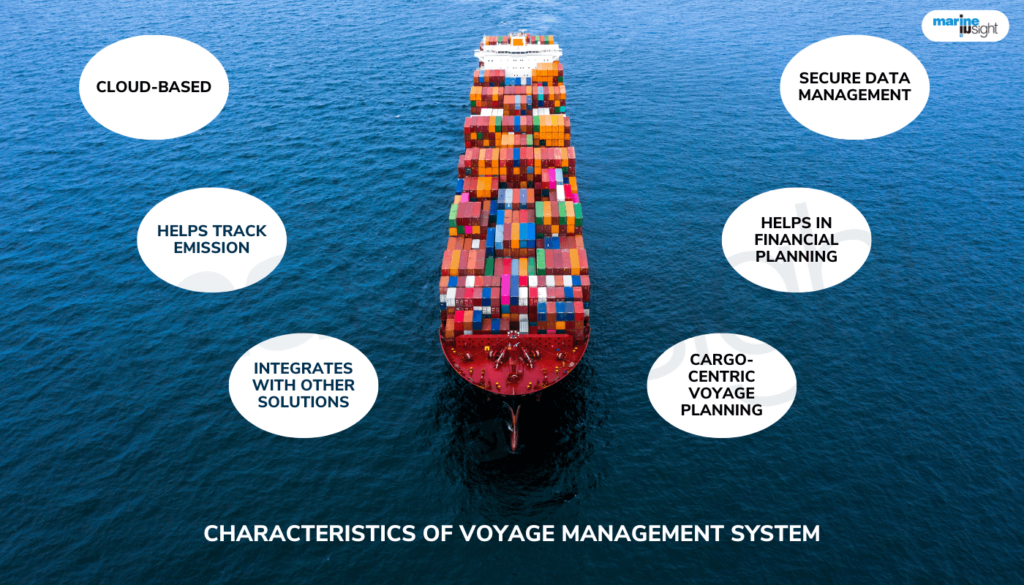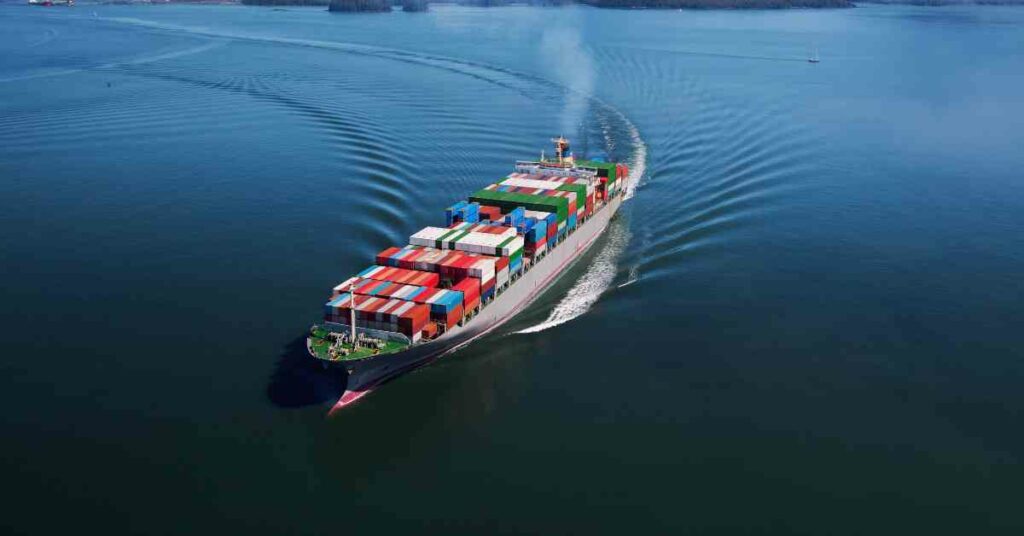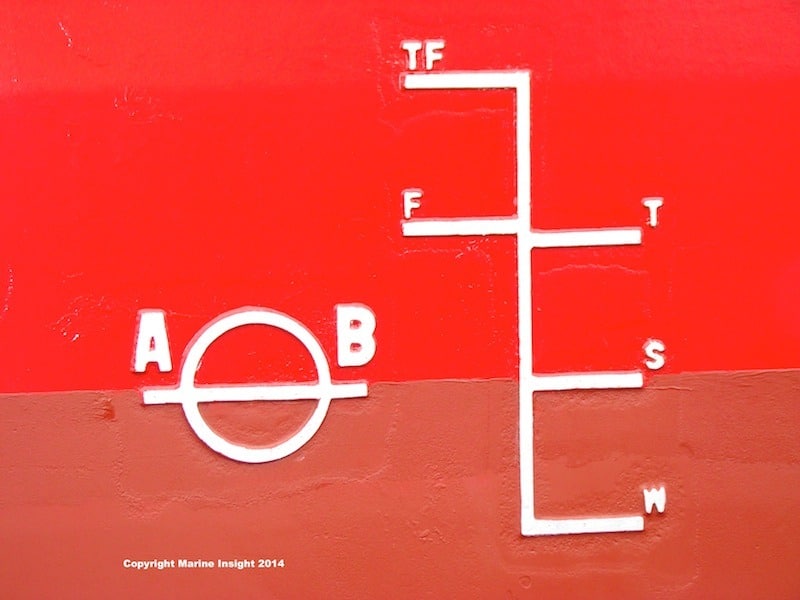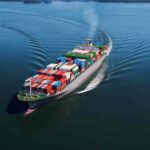What Are Cardinal Marks?

In the previous article, we learnt about seamarks and their importance. Sea marks are a system of conventions and reference markings used to guide a navigator or seafarer in specific areas requiring special attention. They are analogous to road signs we see on roads.
We briefly touched upon safe water marks and their significance in indicating safe and navigable waters through their characteristic marking system. This article will briefly overview another kind of seamark known as cardinal marks.
Cardinal marks are a crucial system of markings similar to safe watermarks but are essentially direction-based. Their name is derived from the mathematical concept of cardinality, or in simple words, grouping.
Hence, the cardinal marks are grouped or instead organised into four distinct categories of markings, often represented as quadrants based on directionality as per the compass rule:
- North Cardinal
- East Cardinal
- South Cardinal
- West Cardinal
The use of these cardinal marks is mainly for:
- Guiding a vessel through safe and deepest waters
- Indication of safe waters in case of a hazard, danger, or obstruction
- Indicate the presence of some interfering landmass, sharp turns, bends, junctions, and so on.
The cardinals indicate the safe, navigable waterways relative to their absolute location in terms of geographical direction, as seen by a seafarer when approaching an area of attention from any given direction.
Each of the four types of cardinal marks mentioned above is distinct or unique and thus aids in identifying the exact location of avoidance and, therefore, the navigable water to ply through.

Let me start with an example. There is a shipwreck or an accident site at a particular place. Due to fog and reduced visibility, a ship approaching the site from a specific direction does not know the location.
However, the navigator or captain from the helm manages to spot a cardinal mark pertaining to a definite direction, for instance, the west. This means that the hazard mainly lies eastwards, and the vessel needs to make a hard turn towards the west of the mark to ply through safely.
Assuming the vessel’s compass or navigational mechanism is fully functional, the navigator turns the rudder towards the west so that the vessel’s heading is aligned with the west compass direction and the ship can pass safely.
Similarly, a trawler in a river is unaware that a sharp and precarious turn is lying ahead. However, an east cardinal mark can be seen. This means that the waters east of the mark are safe, and the vessel needs to turn eastwards to avoid collision with the land.
This example makes it even clearer. As per historical accounts and reports and depictions in books and movies, the fated Titanic encountered the infamous iceberg from her starboard side or right of her heading direction.
For simplicity, assuming a linear voyage path in a westward heading as per its course from Britain to New York, the iceberg was situated northward as per geographical compass coordinates.
So, in an imaginary situation, if hypothetically someone had placed a south cardinal at some miles distance before the iceberg, the vessel could have made a southward or a portside turn away from the berg in prior and saved itself!
For all practical purposes, in localised sites like the shipwreck example above, cardinal marks are placed in all directions around the area of attention. So, the vessel mentioned in the above example can also take a hard turn eastwards when it spots an eastern cardinal to avoid obstruction.
After that, the vessel is likely to spot a north or south cardinal depending on its direction of approach, and this means that the waters north or south of the accident site are free of any risks, and the vessel can move ahead unhindered. The following figure depicts a generic representation of cardinal marks. The north side, or the north cardinal, is aligned with the geographic north.
Like safe water marks, the cardinal marks are governed by the guidelines and regulations of the International Associations of Lighthouse Authorities (IALA).
For all practical purposes, cardinal marks are average-sized floating-type marks like buoys. They are primarily pillar-like, spar-like or tapering in shape. They are 2-3 metres in diameter but may weigh up to 5 or 6 tonnes (a large SUV or mini-truck). They are moored or tethered to the seafloor by cables or tethers.
The four cardinal marking systems are distinct in colour coding and lighting arrangement. As we already know, the colour coding system plays the marking role during the day and the lighting during the dark.
Above the main structure, there is another pointed mark known as the top mark, defined in terms of small black arrows (similar to a weatherman’s cock) that are oriented in 4 different ways depending on the direction cardinality. The light or beam is usually towards the top-end of the structure close to the top marks.
Let us now see how these four marks are different from one another.
- North Cardinal
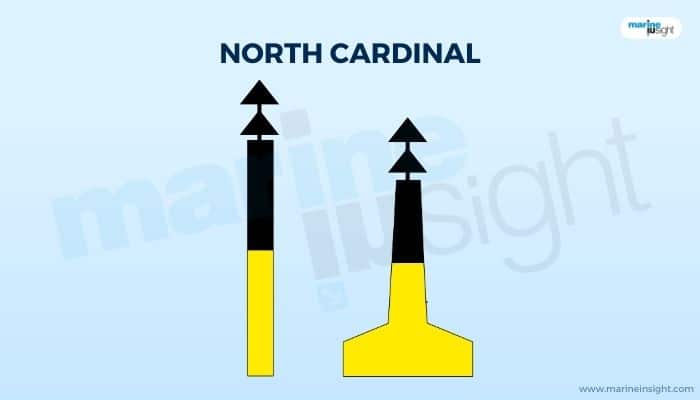
As we know, they represent the safe, navigable waterway relative north of its position. Here, essentially, the lower and wider base of the structure is yellow, and the narrower top part is black. The top marks are black, and both successively point upward towards the sky. Refer to the above diagram. At night, the beam continuously emits flashes at very short intervals, like a car indicator lamp.
- East Cardinal

They indicate safe waters east of its location. Here, the colour coding is slightly more complicated. The broader base or lower part of the structure is black, the lower part of the upper or narrower structure is yellow, and the upper part of the upper structure is black again.
The colour coding can be remembered as B-Y-B for black-yellow-black. The top arrows are fully black and point opposite to one another such that their apexes are away from each other, similar to two interposed cones or a diamond shape.
The beam emits three short flashes at night every 10 or 15 seconds. When they flash every 10 seconds, they are known as Very Quick Flashes; when they flash every 15 seconds, they are quick flashes.
- South Cardinal

They indicate safe waters south of its position. The lower part is black, and the upper is yellow, the reverse of the north cardinal, when going from bottom to top. The top marks are precisely opposite to that of the north cardinal, with both pointing downwards.
The light patterns are complicated here. Six short flashes are followed by a long flash every 10 to 15 seconds (6+1). Like above, the time interval decides whether they are quick or very quick types.
- West Cardinal
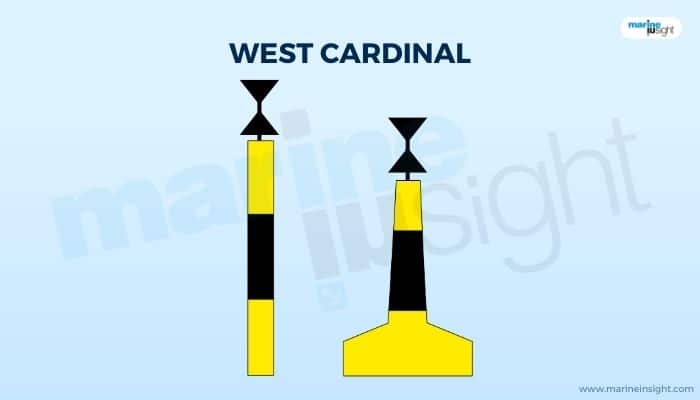
Lastly, the west cardinal marks indicate that the water westwards is safer. The broader base or lower part of the structure is yellow, the lower part of the upper or narrower structure is black, and the upper part of the upper structure is yellow again. The colour coding can be remembered as Y-B-Y for yellow-black-yellow. The top mark arrows again point in the opposite ways, but this time, towards one another, like a wineglass or a sand clock.
The lighting arrangement flashes nine times during the dark every 10 or 15 seconds.
While using reference, the marks are easily detected and identified during the day or with clear visibility; at night, it becomes even more critical, especially for south and west marks, as they are similar and can be easily confused. Thus, careful observation, preferably multiple times, is crucial.
The distinct lighting pattern can also be easily identified and remembered in the following way. Suppose you are standing on the road. A person to your east is basically at your 3 o’clock position, or the hands of the clock during 3 pm or am.
So, that’s the number of times the light flashes for an east cardinal! Similarly, a person right behind you is at your 6 o’clock position, and the one at your west is at 9 o’clock. So, likewise, at the number of flashes for the respective cardinals.
Similarly, other than the standard colour coding, the cardinal marks are characteristic of retroreflectors that enhance appearance by reflecting off incident light on the marks.
You might also like to read-
- What Are Deck Seals?
- What are Margin Plates in Ships?
- Differences And Correlation Between Spot Rates And Contract Rates in Shipping
- Advantages And Disadvantages Of Bigger Vessels For Exporters, Shippers & Cargo Owners
Do you have info to share with us ? Suggest a correction

About Author
Subhodeep is a Naval Architecture and Ocean Engineering graduate. Interested in the intricacies of marine structures and goal-based design aspects, he is dedicated to sharing and propagation of common technical knowledge within this sector, which, at this very moment, requires a turnabout to flourish back to its old glory.
Latest Marine Navigation Articles You Would Like:
Subscribe To Our Newsletters
By subscribing, you agree to our Privacy Policy and may receive occasional deal communications; you can unsubscribe anytime.



